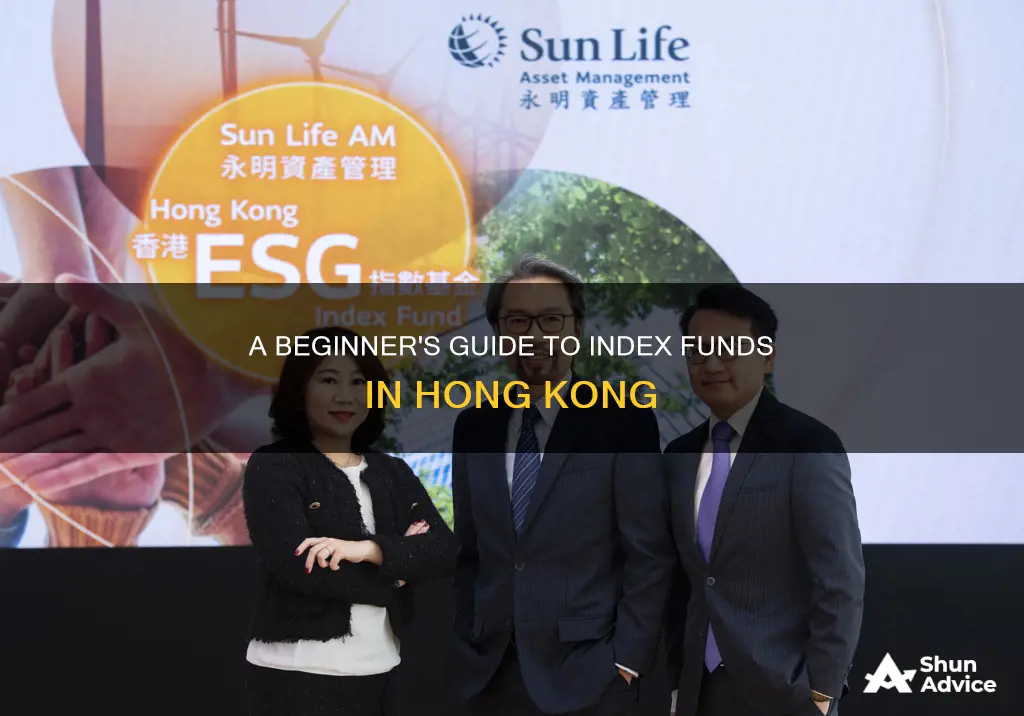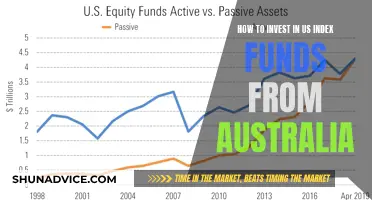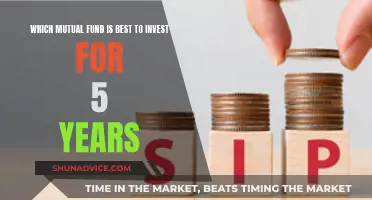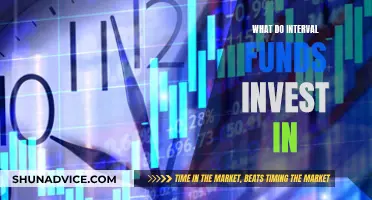
Index funds are a type of mutual fund that tracks the performance of a stated financial market index. They are a simple, low-cost option for portfolio diversification, especially if you are optimistic about an asset class or market but are unfamiliar with security or company selection. In Hong Kong, there are several index funds available, including the Tracker Fund of Hong Kong Ltd, which replicates the performance of the Hang Seng Index, and the CAM CSI300, which aims to replicate the CSI 300 Index. When investing in index funds, it is important to carefully consider the risks involved, as all investments carry a certain level of risk, including the possibility of losing the capital invested.
| Characteristics | Values |
|---|---|
| Type of fund | Mutual fund |
| Investment approach | Passive |
| Investment objective | Track performance of a stated financial market index |
| Investment benefits | Simple, low-cost option for portfolio diversification |
| Investment risks | Possibility of loss of capital invested, higher volatility, higher credit/counterparty and liquidity risks |
| Investment suitability | Investors who are optimistic about an asset class or market but are unfamiliar with security or company selection, or are worried about concentrated risk |
| Investment process | Create a brokerage account, fund the account, search for index funds, confirm and purchase |
| Investment fees | Brokerage exchange commissions, platform fees, agent commissions |
What You'll Learn

Index funds vs. actively managed funds
Index funds are a type of mutual fund that aims to track the performance of a stated financial market index. They do this by building a portfolio that invests in all or part of the constituent stocks or bonds of that particular index. Index funds are passively managed, meaning they operate with minimal human intervention. This results in lower investment advisory fees.
Actively managed funds, on the other hand, are typically mutual funds where individuals or companies make decisions based on what they believe will create the best return for investors. This active investment management style generally comes with higher fees, expressed as an "expense ratio".
Both types of funds have their merits. Index funds are a smart option for a core portfolio, while actively managed funds can be valuable complements to capture additional potential returns in certain market segments. Together, they can form a more comprehensive and diversified portfolio.
The choice between the two ultimately comes down to an investor's risk tolerance, investment style, and strategy. Index funds are a good option for those who want a more hands-off approach, while actively managed funds offer more flexibility and the potential upside of a professionally managed fund.
Investments Funding Social Security: State-Sponsored Retirement Plans
You may want to see also

ESG scores and sustainable investing
ESG stands for Environmental, Social, and Governance. It provides a framework for investors to assess the sustainability and longevity of an investment. This is in addition to evaluating its financial performance.
The Environment criteria assess how a company handles its waste, resources, and environmental impact, such as its carbon footprint. An environmentally sustainable company is more likely to gain public confidence and thrive as governments implement more climate-friendly policies.
The Social criteria assess how a company interacts with its communities and whether it treats its employees fairly, sources fair labour, and has diversity policies in place. Organisations that positively impact whole communities are more likely to thrive as those who come into contact with them – whether as customers or direct or indirect employees – are satisfied. This has multiple benefits that trickle down to affect a company’s bottom line, from higher employee retention rates to strong community and industry representation.
The Governance criteria assess a company’s framework for decision-making and legal compliance. Strong governance ensures that companies distribute their resources fairly, deal appropriately with bribery or fraud, and avoid conflicts of interest at the board level. Companies with robust governance are more likely to practice fairness and transparency and be more stable in the long term.
ESG isn't the only sustainable investing strategy. There's also Socially Responsible Investing, which takes things a step further by actively eliminating investments based on ethical criteria. Impact Investing, a subset of Socially Responsible Investing, only considers an investment's sustainability impact, regardless of its financial performance.
ESG differs from these other strategies as it builds on traditional investment strategies. This means that, in addition to an asset's financial performance, ESG also focuses on how it impacts sustainability.
Despite ESG's increasing popularity, there is currently no universal standard or commonly accepted methodology for calculating ESG ratings. This can create confusion for investors, as different rating agencies may provide inconsistent scores for the same company. For example, Tesla Inc. is rated average by MSCI ESG ratings but is categorised as high risk by Sustainalytics.
However, some institutions have developed ESG scoring to help fund managers build ESG-friendly portfolios. MSCI and Morningstar, for example, assign ESG ratings based on how a company manages its ESG risks compared to other companies within the same industry.
Currently, multiple ESG organisations and the International Financial Reporting Standards are taking steps to standardise ESG criteria, including collaborating with other institutions to create universal standards.
As green finance and sustainable investing become a global trend, it is also taking root in Hong Kong. The HKSAR Government launched the Government Green Bond Programme in 2018 with a borrowing ceiling of $100 billion. Financial regulators and related authorities have also implemented various initiatives, such as the Green Finance Certification Scheme, to support the local green finance market.
There are now about 30 SFC-authorised green and ESG funds in the Hong Kong market.
Mutual Fund Investment Guide for Filipinos
You may want to see also

Hong Kong ETFs
Exchange-traded funds (ETFs) are a popular investment vehicle for those looking to gain exposure to a specific market or industry without having to purchase individual stocks. Hong Kong ETFs are no exception, and there are several options available for investors interested in this market.
One of the most popular Hong Kong ETFs is the iShares MSCI Hong Kong ETF (EWH), which tracks the investment results of an index composed of Hong Kong equities. This ETF provides exposure to large and mid-sized companies in Hong Kong and can be used to express a single-country view. The Franklin FTSE Hong Kong ETF is another option that falls under the category of Developed Asia Pacific and Asia Pacific Equities.
When considering investing in Hong Kong ETFs, it is important to keep in mind the risks associated with international investing, including foreign currency fluctuations, limited liquidity, and the possibility of substantial volatility due to political and economic developments. Additionally, investors should carefully review the prospectus and offering documents to understand the specific risks and fee structures associated with each ETF.
For those looking to diversify their portfolios and gain exposure to the Hong Kong market, Hong Kong ETFs can be a convenient and cost-effective option. By investing in a basket of Hong Kong-listed stocks through an ETF, investors can benefit from the potential growth and stability of this market while minimising the time and research required to select individual stocks.
Covered Funds: A Smart Investment Strategy?
You may want to see also

US ETFs
US-listed Exchange-Traded Funds (ETFs) are a good option for investors in Hong Kong who are looking for a lower-cost way to diversify their investment portfolios. Unlike HK-listed stocks, US-listed stocks and ETFs require a smaller minimum investment amount, as you can buy just one share.
US-listed ETFs are traded on the stock exchange in the same way as US stocks. The smallest trading unit is one share, and the fees are similar to those for trading ordinary US stocks. However, investors should be aware that ETFs also incur certain fees and charges, such as management fees, which are deducted from the ETF's assets.
US-listed ETFs offer high liquidity and trading volume, and they contain a basket of stocks that balances overall performance. This allows investors to diversify their portfolios at a lower entry fee compared to ordinary stocks.
There are two main types of ETFs: "passive" and "active". Passive ETFs aim to track the performance of an underlying index or benchmark, while active ETFs have fund managers who select the financial products to be invested and actively manage the investment portfolio to achieve its investment objective. Inverse and leveraged ETFs are also available, mainly for hedging purposes.
When investing in US-listed ETFs, it is important to consider the track record of the fund manager and understand the key features and risks involved, such as tracking errors and trading risks.
- SPDR Dow Jones Industrial Average ETF (DIA)
- S&P 500 ETF (SPY)
- Nasdaq 100 ETF (QQQ)
Maximizing Your HSA: Investing in Bogelheads for Secure Returns
You may want to see also

Advantages and disadvantages of passive management
Index funds are a type of mutual fund that aims to track the performance of a stated financial market index. They are a simple, low-cost option for portfolio diversification. Index funds are defined as passive investments, meaning they mirror the performance of benchmarks like the S&P 500 by mimicking their makeup.
Advantages
- Lower fees: Passive funds tend to have lower expense ratios because they are passively managed and do not require costly research. Index funds, for example, simply follow the index they use as their benchmark.
- Transparency: It is clear which assets are in a passive fund, making it easy for investors to understand what they are invested in.
- Tax efficiency: The buy-and-hold strategy of passive funds does not typically result in a massive capital gains tax for the year.
- Simplicity: Owning an index or group of indices is easier to implement and understand than a dynamic strategy that requires constant research and adjustment.
- Historical performance: Over the long term, passive funds have often outperformed actively managed funds, especially after accounting for fees and expenses.
Disadvantages
- Lack of flexibility: Passive funds are limited to a specific index or set of investments and are not able to pivot when the market shifts.
- Smaller potential returns: Passive funds rarely beat the market and are designed to provide returns that closely track their benchmark index.
- Reliance on others: Passive investors rely on fund managers to make decisions and do not have a say in what they are invested in.
- Market risk: Passive funds are subject to market risk and will decline in value when the market does.
Overall, passive management can be an attractive option for hands-off investors who want solid returns with less risk over a longer period.
Global Bond Funds: Diversify and Grow Your Investments
You may want to see also
Frequently asked questions
Index funds are a type of mutual fund that tracks the performance of a financial market index by investing in the stocks or bonds that make up that index. They are a simple, low-cost way to diversify your portfolio.
Index funds offer a simple, low-cost way to achieve portfolio diversification. They are also liquid, allowing you to easily enter and exit investments. Additionally, they have high capacity and can absorb large investment inflows quickly. Fees for index funds also tend to be lower than for active funds.
To start investing in index funds, you will need to open a brokerage account with an online broker. You will then need to fund your account before you can begin investing. Once your account is funded, you can search for and trade index funds, just like you would trade shares of stocks.
Some popular index funds in Hong Kong include the Tracker Fund of Hong Kong Ltd(02800), CAM CSI300(03188), and HSCEI ETF(02828). These funds aim to replicate the performance of indices such as the Hang Seng Index and the Hang Seng China Enterprises Index.







